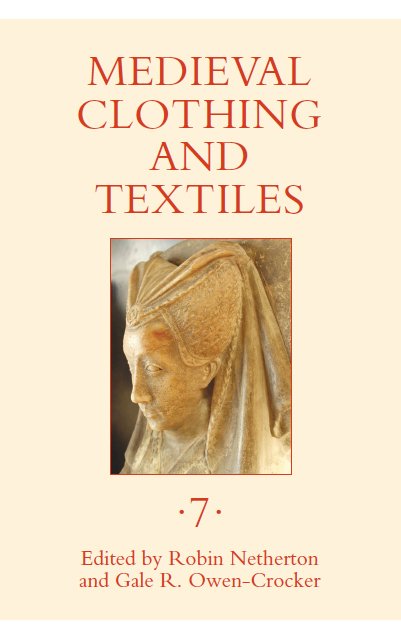Book contents
- Frontmatter
- Contents
- Illustrations
- Tables
- Contributors
- Preface
- The Empress’s New Clothes: A Rotulus Pannorum of Isabella, Sister of King Henry III, Bride of Emperor Frederick II
- Unveiling Social Fashion Patterns: A Case Study of Frilled Veils in the Low Countries (1200–1500)
- What Is the Pearl-Maiden Wearing, and Why?
- “Hys surcote was ouert”: The “Open Surcoat” in Late Medieval British Texts
- London Merchants’ Cloth Exports, 1350–1500
- Laboreria Sete: Design and Production of Lucchese Silks in the Late Fourteenth and Early Fifteenth Centuries
- Recent Books of Interest
- Contents of Previous Volumes
“Hys surcote was ouert”: The “Open Surcoat” in Late Medieval British Texts
Published online by Cambridge University Press: 18 February 2023
- Frontmatter
- Contents
- Illustrations
- Tables
- Contributors
- Preface
- The Empress’s New Clothes: A Rotulus Pannorum of Isabella, Sister of King Henry III, Bride of Emperor Frederick II
- Unveiling Social Fashion Patterns: A Case Study of Frilled Veils in the Low Countries (1200–1500)
- What Is the Pearl-Maiden Wearing, and Why?
- “Hys surcote was ouert”: The “Open Surcoat” in Late Medieval British Texts
- London Merchants’ Cloth Exports, 1350–1500
- Laboreria Sete: Design and Production of Lucchese Silks in the Late Fourteenth and Early Fifteenth Centuries
- Recent Books of Interest
- Contents of Previous Volumes
Summary
… documentary evidence raises all sorts of problems for collectors and collators of data: the substitution of the vernacular for Latin and the use of words with scant relationship to Latin, plus the borrowing of terms from one vernacular language to another. The proliferation of terminology [in the mid-fourteenth century] occurred in response to an outburst of creativity in styles of design, the advent of all sorts of new materials and the increasing significance of colour.
Statements such as this one by Françoise Piponnier and Perrine Mane point toward the fact that costume historians regularly encounter two important lexicological phenomena when dealing with the vocabulary of cloth and clothing in later medieval Britain: first, that a multitude of languages and, often, what we might now assume to be language mixing, “codeswitching,” or else borrowing occurs frequently in surviving documentary evidence, and second, that the fourteenth century in particular has more than its fair share of new lexical items from across the multilingual spectrum. Historians of cloth, clothing, and related material cultures frequently express the difficulty of accurately matching a name to a garment, and, generally speaking, modern terminology often proves the most efficacious, despite the misconceptions this might occasionally foster.
While sticking to contemporary vocabulary may assist accuracy in our attempts to name garments, nonchalant medieval (and particularly late medieval) attitudes toward language “mixing,” the frequency of borrowing, and piecemeal preservation in the various learned tongues of wardrobe keepers can create difficulty. Often, for example, it can even prove difficult to assign a specific language to a word, as the medieval abbreviation system regularly focuses “concentration on the essential semantic, as opposed to the morphological, information on the material.” Laura Wright’s recent identification of specific noun phrases drawn from English in late medieval macaronic business writing (where Latin or French forms the base language) has cast new light on the often multilingual nature of fourteenth-century record-keeping. Monolingual dictionaries are not always able to include evidence from such mixed-language (or non-language-specific) texts, and hence our understanding of the history of a particular lexeme—especially a technical lexeme such as may be found in wardrobe accounts, etc.—can be left wanting.
Historical linguistics dealing with late medieval Britain is in the midst of a mixed-language season of late, as the study of the dynamically versatile, multilingual medieval texts continues to hold scholarly attention.
- Type
- Chapter
- Information
- Medieval Clothing and Textiles 7 , pp. 87 - 110Publisher: Boydell & BrewerPrint publication year: 2011



